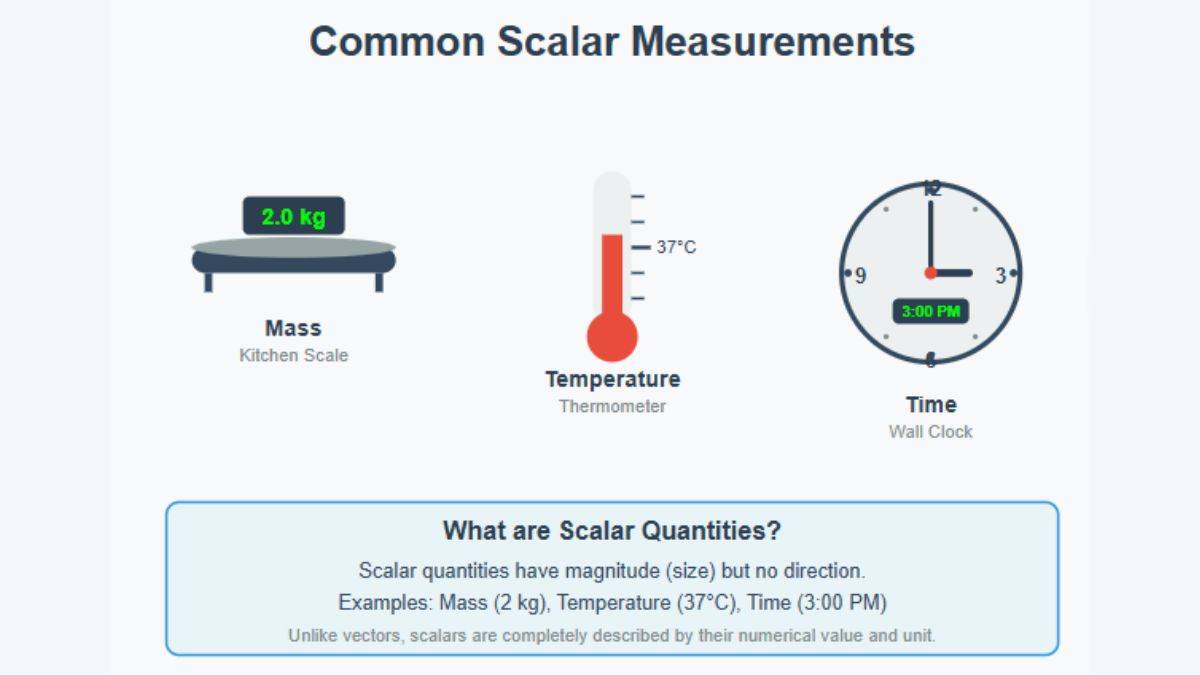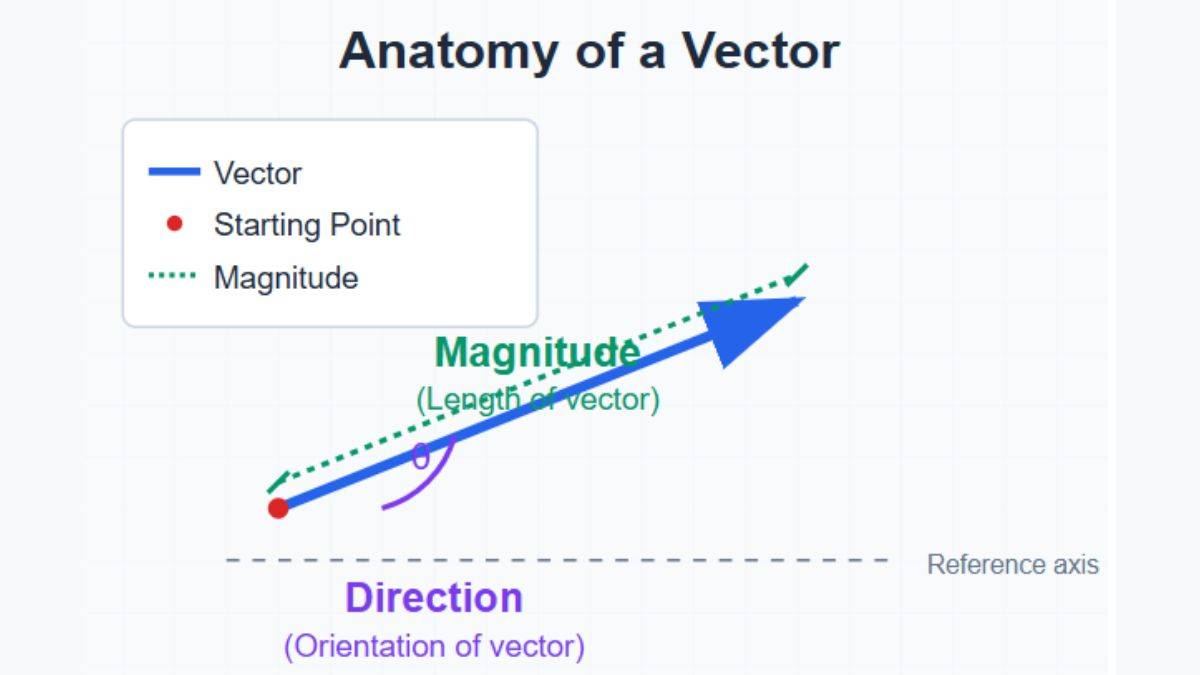
When we describe how far we’ve travelled, we usually use a number and a unit. It could be 5 km, 5 feet, or 5 miles. That’s just distance. That’s also a scalar quantity. Because we are not describing the direction or the velocity.
But what if someone asks how fast you were going at a particular moment and in which direction? You will calculate instantaneous velocity and say you travelled 5 km/hr east. It’s not just distance. You’re considering the displacement or change in position, which has both magnitude and direction. That’s a vector quantity.
In physics, scalars and vectors are two categories to classify physical quantities. Let’s learn more.
- What is a Scalar Quantity?
- What is a Vector Quantity?
- Key Vector Concepts in Physics: Class 11 Notes
- Scalar vs Vector: A Comparison
- Scalar and Vector Quantities - JEE-Level Examples
- Revise Physics Chapters with Our Detailed Notes
- Practice NCERT Solutions Physics Class 11
What is a Scalar Quantity?
A scalar quantity in physics is a description of magnitude.
It consists of a single number and its corresponding unit of measurement.
You can consider scalars as simple numerical values that answer the question "how much?". This does not require you to tell which direction you are headed.
Key Characteristics of Scalars
- Definition: Possesses magnitude only.
- Specification: Always defined by a number and a unit (e.g., 10 kg, 30°C)
Examples of Scalar Quantities
- Distance: The total path length covered between two points (e.g., 5 km).
- Mass: How much matter an object has (e.g., 70 kg).
- Temperature: How hot or cold a body is (e.g., 25 degrees Celsius).
- Time: How long is one event (e.g., 60 seconds).
Scalar Algebra
Scalar quantities follow basic arithmetic when it comes to combining them.
- Addition and Subtraction: You can add or subtract scalars. The only condition for that is that they must have the same units. For instance, you can add 5 kg and 2 kg to get a total of 7 kg. But it’s impossible to add 5 kg to 10 meters.
- Multiplication and Division: Multiplication and division are also possible with scalars. They don't have to have the same units. For instance, you can calculate density by dividing mass by volume.
What is a Vector Quantity?
A vector quantity has magnitude and a specific direction in space.
This quantity in physics tells us that, in addition to knowing 'how much', we should also know 'which way'.
Key Characteristics of Vectors
- Definition: It must have magnitude and direction.
- Vector Addition: Vectors are ruled by specific laws. Typically, they follow the triangle law of addition or the parallelogram law of addition. They are different from simple arithmetic.
Triangle Law of Addition - This applies when we have two vectors that are placed head-to-tail. Their sum is the vector from the tail of the first to the head of the second.
Parallelogram Law of Addition - When two vectors form adjacent sides of a parallelogram, their sum is the diagonal vector from their common origin.
Examples of Vector Quantities
- Displacement: The change in position in a specific direction.
- Velocity: The rate of change of displacement (speed in a direction).
- Acceleration: The rate of change of velocity.
- Force: A push or pull on an object in a specific direction.
How to Represent Vectors
To differentiate vectors from scalars in physics, we use specific notations.
- In typed text: Vectors are represented using boldface letters such as v, a, and F.
- In handwritten work: Vectors are denoted by placing an arrow above the letter, written as , , and .
- Magnitude Notation - The magnitude (or length) of a vector is always a positive scalar value. There are two standard ways to express vector magnitude.
- Using the same letter in regular (non-bold) typeface: the magnitude of v is written as v
- Using absolute value notation: the magnitude of v can also be written as |v|
Both notations represent the same concept. It's the scalar distance or size of the vector quantity.
Key Vector Concepts in Physics: Class 11 Notes
Vectors essentially describe motion and position in space. Here are two fundamental applications.
Position and Displacement Vectors
To describe an object's location, we first need a frame of reference. Typically, we can go for a coordinate system with an origin point (O).
Position Vector (r): This is a vector that extends from the origin (O) to the object's current location (P). It tells us exactly where the object is relative to our reference point.
Displacement Vector (Δr): If an object moves from an initial position (P) to a final position (P'), the displacement vector is the straight-line vector pointing from P to P'.
A displacement vector only depends on the initial and final positions. It’s independent of the actual path taken. Because of this, the magnitude of the displacement is always less than or equal to the total path length (distance) travelled.
Equality of Vectors
Often, you will be asked in annuals and competitive tests, such as the JEE Main, to solve problems regarding the equality of vectors. It’s better to understand the conditions behind it.
Two vectors, A and B, are considered equal if and only if they meet two conditions.
- They have the same magnitude (|A| = |B|).
- They have the same direction.
Knowing this, a vector's starting location does not define it.
You can move a vector parallel to itself anywhere in space, and it remains the same vector. Such vectors are known as free vectors.
Additionally, explore the curated NCERT Solutions for Motion in a Plane.
Scalar vs Vector: A Comparison
For quick reference, here are the differences between scalar and vector quantities.
| Basis for Comparison |
Scalar Quantities |
Vector Quantities |
| Definition |
A quantity with magnitude only. |
A quantity with both magnitude and direction. |
| Specification |
A single number and a unit. |
A number, a unit, and a direction. |
| Algebra |
Follows ordinary algebra. |
Follows vector algebra (e.g., Triangle Law). |
| Examples |
Mass, Speed, Distance, Temperature, Time. |
Displacement, Velocity, Acceleration, Force. |
Scalar and Vector Quantities - JEE-Level Examples
Here are some JEE style questions you can prepare when it comes to scalars and vectors. Before checking them, just follow along the few points below.
- Addition and subtraction are commutative and associative.
- Dot product is zero for perpendicular vectors; cross product is zero for parallel vectors.
- Unit vectors satisfy .
Example 1: Two vectors and represent displacements. Find the magnitude of the resultant displacement.
Resultant: . Magnitude: .
Example 2: Find the angle between vectors and using the dot product.
Dot product: . Magnitudes: . Angle: .
Example 3: A boat moves at across a river flowing at . Find the magnitude of the boat's velocity relative to the ground.
Boat's velocity: , river's velocity: . Resultant: . Magnitude: .
Revise Physics Chapters with Our Detailed Notes
Click on the chapters for Physics and find detailed guides.
| Units and Measurements Class 11 Notes | Mechanical Properties of Solids Class 11 Notes |
| Motion in a Straight Line Class 11 Notes | Mechanical Properties of Fluids Class 11 Notes |
| NCERT Class 11 Notes for Motion in a Plane | Thermal Properties of Matter Class 11 Notes |
| Laws of Motion Class 11 Notes | Thermodynamics Class 11 Notes |
| Work, Energy, and Power Class 11 Notes | Kinetic Theory of Gas Class 11 Notes |
| System of Particles and Rotational Motion Class 11 Notes | Oscillations Class 11 Notes |
| Gravitation Class 11 Notes | Waves Class 11 Notes |
Some more Science stream notes for Class 11 CBSE to check.
| NCERT Class 11 Notes for PCM |
| NCERT Class 11 Physics Notes |
Practice NCERT Solutions Physics Class 11
Find the NCERT Solutions for all the chapters in Class 11 right here.
Keep exploring the regularly updated NCERT Solutions for Physics Class 11!
Commonly asked questions
What are three common vectors?
Displacement, velocity, and acceleration are common vectors. These three vectors they have both magnitude and direction, and follow vector addition rules.
Is speed vector or scalar?
Speed is a scalar quantity. It only has magnitude and no direction, unlike velocity, which is a vector.
What are two scalars?
Mass and temperature are scalars. We can fully describe them by magnitude alone and do not involve direction.
Physics Motion in Plane Exam
Student Forum
Other Class 11th Physics Chapters
- Physics Mechanical Properties of Solids
- NCERT Class 11 Physics
- NCERT Class 11 Notes
- NCERT Notes
- Physics Motion in Plane
- Physics Mechanical Properties of Fluids
- Physics Motion in Straight Line
- Physics System of Particles and Rotational Motion
- Physics Oscillations
- Physics Waves
- Physics Thermal Properties of Matter
- Physics Motion
- Physics Gravitation
- Physics Thermodynamics
- Physics Work, Energy and Power
- Physics Units and Measurement
- Physics Laws of Motion



